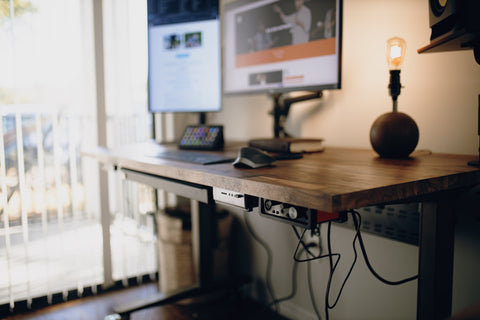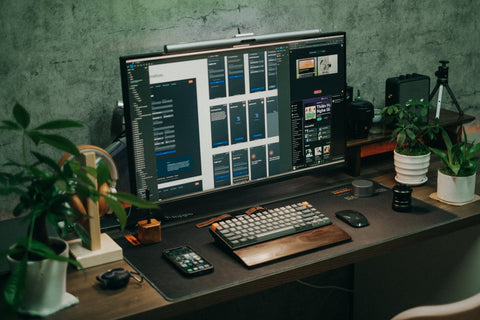The Importance of Ergonomics: Choosing the Right Office Furniture
When it comes to furnishing your workspace, it's important to prioritize the well-being and productivity of yourself and your employees. That's where the concept of ergonomics comes in. Ergonomic office furniture is designed to support the body and reduce the risk of injury or discomfort caused by prolonged sitting or repetitive tasks.
Choosing the right ergonomic office furniture can make a significant difference in the overall health and happiness of your team. In this article, we'll discuss the benefits of ergonomic office furniture, what it is, the different types available, how to choose the right furniture, and more. By the end, you'll have a complete understanding of how to create a workspace that promotes comfort, health, and productivity.

What is Ergonomic Office Furniture?
Ergonomic office furniture is designed to support the body in a way that promotes comfort and health. Unlike traditional office furniture that may contribute to poor posture and discomfort, ergonomic furniture is designed to reduce strain and stress on the body.
The key features of ergonomic office furniture include adjustability, support, and comfort. Ergonomic chairs, for example, typically have adjustable seat height and armrests, lumbar support, and a comfortable seat cushion. Ergonomic desks may be adjustable in height to accommodate different positions, and may feature a tilted surface to reduce strain on the neck and shoulders.
What makes ergonomic furniture different from traditional furniture?
Ergonomic furniture is designed with the user's body in mind. It is meant to reduce physical stress and discomfort by providing proper support and adjustability to promote healthy posture. Traditional furniture, on the other hand, may not consider the ergonomics of the user's body and may contribute to poor posture and discomfort.
Types of Ergonomic Office Furniture

When it comes to creating an ergonomic office, the right furniture is crucial. Here are some of the most common types of ergonomic office furniture:
|
Item |
Description |
|
Ergonomic Chairs |
Designed to provide proper support to the back, neck, and arms, ergonomic chairs are key to preventing discomfort and injury caused by sitting for extended periods of time. Look for chairs with adjustable height, armrests, and lumbar support. |
|
Standing Desks |
Research shows that standing for part of the workday can help increase productivity and reduce the risk of health issues caused by prolonged sitting. Standing desks are height-adjustable and can be used while sitting or standing. |
|
Document Holders |
Placing documents at the right angle and height can reduce eye, neck, and shoulder strain. Document holders can be positioned next to the computer screen for easy reference. |
|
Ergonomic Keyboards and Mice |
Repetitive strain injuries from typing and using a mouse can be prevented by using ergonomic keyboards and mice. Look for designs that position the hands and wrists in a neutral position. |
|
Footrests |
Footrests can help reduce pressure on the lower back and legs, particularly for shorter individuals who may not be able to adjust their chair height sufficiently. |
Investing in ergonomic office furniture can help improve comfort, prevent injury, and boost productivity. Consider which types of furniture will best meet your needs and budget.
H2: Benefits of Ergonomic Office Furniture
Investing in ergonomic office furniture can have numerous benefits for both employees and employers. Here are some of the key advantages:
- Improved posture: Ergonomic chairs and desks are designed to promote proper posture to reduce strain on the neck, back, and shoulders. This can help prevent long-term health problems such as chronic pain.
- Reduced risk of injury: Repetitive strain injuries (RSIs) and other workplace injuries can be reduced by using ergonomic furniture that is tailored to the individual's needs and promotes proper alignment and movement.
- Increased comfort: Ergonomic furniture is designed with comfort in mind, offering features such as adjustable armrests, lumbar support, and breathable materials that help to reduce discomfort and fatigue.
- Better productivity: By promoting better posture and reducing discomfort, ergonomic furniture can help employees focus and stay productive for longer periods of time.
- Boosted morale and well-being: Providing comfortable and supportive ergonomic furniture can lead to happier and more satisfied employees, which can have a positive impact on overall workplace morale and company culture.
Studies have shown that investing in ergonomic furniture can lead to a significant return on investment in terms of reduced absenteeism, increased productivity, and lower healthcare costs. By prioritizing the well-being and comfort of employees, companies can create a more positive and productive work environment.
How to Choose the Right Ergonomic Furniture

Choosing the right ergonomic office furniture can be a daunting task, but it doesn't have to be. Here are some tips to help you select the right furniture:
- Consider individual needs: Everyone's body is different, so it's important to choose ergonomic furniture that will meet your specific needs. Take into account your height, weight, and any health conditions you may have.
- Test out products: Before making a purchase, test out different ergonomic furniture products to see which ones feel the most comfortable. Don't be shy about asking for a demonstration or trying out different adjustments.
- Consult with experts: If you're not sure which ergonomic furniture products are right for you, consider consulting with an ergonomic specialist. They can help you choose products that will provide the best support for your body.
- Look for adjustability: Ergonomic furniture should be adjustable to meet your needs. Look for chairs that can be adjusted for height and armrests, desks that can be raised or lowered, and other accessories that can be customized to your body's needs.
- Choose quality: When it comes to ergonomic furniture, you often get what you pay for. Invest in high-quality products that will last for many years and provide the support your body needs.
- Customize for comfort: Don't be afraid to customize your ergonomic furniture for maximum comfort. Add cushions, footrests, and other accessories to make your workspace as comfortable as possible.
Remember, choosing the right ergonomic furniture is an investment in your health and well-being. By taking the time to choose the right products, you can reduce your risk of injury and increase your overall comfort and productivity.
Ergonomic Office Design
Ergonomic office design is an essential aspect of ensuring the well-being of employees in the workplace. It involves creating a work environment that promotes comfort and productivity while reducing the risk of injury or strain.
The Role of Design
A well-designed office environment can help prevent many common workplace injuries, such as back pain, neck strain, and eye strain. Good office design also promotes productivity by reducing distractions and creating a comfortable, calm atmosphere.
One key aspect of ergonomic office design is lighting. Offices should be well-lit with a combination of natural and artificial light to reduce eye strain and promote productivity. Additionally, office lighting should be adjustable to accommodate individual preferences and needs.
Another consideration in office design is ventilation. Good air quality is essential for maintaining employee health and well-being. Offices should have proper ventilation systems in place to ensure a comfortable, healthy work environment.
Strategies for Ergonomic Office Design
Adjustable desks and chairs are a key aspect of ergonomic office design. They allow employees to adjust their workstations to their individual needs, promoting comfort and reducing the risk of injury. Other important features of an ergonomic office include footrests, wrist supports, and document holders.
Noise reduction is also an important aspect of ergonomic office design. Offices should be designed with sound-absorbing materials and buffering walls to reduce background noise and distractions.
Finally, it's important to consider the layout of the office. Employees should be provided with ample space to move around and stretch throughout the day. The office layout should also be designed to minimize distractions and promote productivity.
Maintaining Ergonomic Office Furniture
Maintaining your ergonomic office furniture is just as important as choosing it in the first place. Proper maintenance can extend the lifespan of your furniture and ensure optimal performance for years to come. Follow these tips to keep your ergonomic office furniture in top shape:
|
Tip |
Description |
|
Regular Cleaning |
Keep your furniture clean and free of dust and debris. Use a damp cloth to wipe down surfaces, and avoid using harsh chemicals that can damage the furniture. |
|
Adjustment Checks |
Regularly check the adjustment mechanisms on your ergonomic furniture to ensure that they are working properly. Adjustments may become loose or stiff over time, so it's essential to test them frequently. |
|
Repairs |
If you notice any damage or wear and tear on your ergonomic furniture, have it repaired right away. Ignoring small fixes can lead to more significant problems down the line. |
|
Protective Measures |
Use protective covers or pads on surfaces that are prone to wear and tear. This can include chair armrests, desk surfaces, and keyboard trays. |
By following these maintenance tips, you can help keep your ergonomic office furniture in excellent condition. Remember that proper maintenance is an investment in the long-term health of your furniture and yourself.
FAQ
Here are some of the most frequently asked questions about ergonomic office furniture:
What are the most important features to look for in an ergonomic chair?
The most important features to look for in an ergonomic chair include adjustable seat height, adjustable armrests, lumbar support, and seat depth adjustment. These features can help ensure proper posture and reduce the risk of pain and discomfort.
How often should I replace my ergonomic desk?
The lifespan of an ergonomic desk can vary depending on the quality and amount of use. However, it is generally recommended to replace your ergonomic desk every 5-7 years to ensure optimal performance and comfort.
Do I need to customize my ergonomic furniture?
Customizing your ergonomic furniture can be beneficial, especially if you have specific needs or health concerns. However, many ergonomic products come with adjustable features that can be tailored to your individual needs without the need for customization.
Can ergonomic furniture really improve my productivity?
Yes, ergonomic furniture can improve productivity by reducing discomfort and preventing injury. When employees are comfortable and healthy, they are more likely to remain focused and productive throughout the day.
Is ergonomic furniture more expensive than traditional furniture?
While ergonomic furniture can be more expensive than traditional furniture, it is important to consider the long-term benefits. By investing in ergonomic furniture, you can reduce healthcare costs associated with employee injuries and improve overall well-being and productivity.
